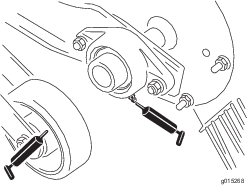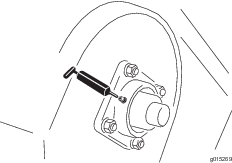| Maintenance Service Interval | Maintenance Procedure |
|---|---|
| Before each use or daily |
|
Introduction
This machine is intended to be used by professional, hired operators in commercial applications. It is designed primarily for removing leaves, pine needles, and other light debris from large turf areas.
Important: To maximize the safety, performance, and proper operation of this machine, carefully read and fully understand the contents of this Operator’s Manual. Failing to follow these operating instructions or to receive proper training may result in injury. For more information on safe operating practices, including safety tips and training materials, go to www.Toro.com.
You may contact Toro directly at www.Toro.com for product and accessory information, help finding a dealer, or to register your product.
Whenever you need service, genuine Toro parts, or additional information, contact an Authorized Service Dealer or Toro Customer Service and have the model and serial numbers of your product ready. Figure 1 illustrates the location of the model and serial numbers on the product. Write the numbers in the space provided.
Important: With your mobile device, you can scan the QR code on the serial number decal (if equipped) to access warranty, parts, and other product information.
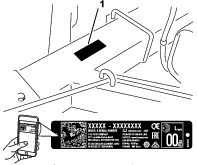
Safety-Alert Symbol
The safety-alert symbol (Figure 2) shown in this manual and on the machine identifies important safety messages that you must follow to prevent accidents.

The safety-alert symbol appears above information that alerts you to unsafe actions or situations and is followed by the word DANGER, WARNING, or CAUTION.
DANGER indicates an imminently hazardous situation which, if not avoided, will result in death or serious injury.
WARNING indicates a potentially hazardous situation which, if not avoided, could result in death or serious injury.
CAUTION indicates a potentially hazardous situation which, if not avoided, may result in minor or moderate injury.
This manual uses two other words to highlight information. Important calls attention to special mechanical information and Note emphasizes general information worthy of special attention.
This product complies with all relevant European directives; for details, please see the separate product specific Declaration of Conformity (DOC) sheet.
It is a violation of California Public Resource Code Section 4442 or 4443 to use or operate the engine on any forest-covered, brush-covered, or grass-covered land unless the engine is equipped with a spark arrester, as defined in Section 4442, maintained in effective working order or the engine is constructed, equipped, and maintained for the prevention of fire.
The enclosed engine owner's manual is supplied for information regarding the US Environmental Protection Agency (EPA) and the California Emission Control Regulation of emission systems, maintenance, and warranty. Replacements may be ordered through the engine manufacturer.
Warning
CALIFORNIA
Proposition 65 Warning
The engine exhaust from this product contains chemicals known to the State of California to cause cancer, birth defects, or other reproductive harm.
Battery posts, terminals, and related accessories contain lead and lead compounds, chemicals known to the State of California to cause cancer and reproductive harm. Wash hands after handling.
Use of this product may cause exposure to chemicals known to the State of California to cause cancer, birth defects, or other reproductive harm.
Safety
General Safety
This product is capable of causing personal injury. Always follow all safety instructions to avoid serious personal injury.
Using this product for purposes other than its intended use could prove dangerous to you and bystanders.
-
Read and understand the contents of both this Operator’s Manual and the operator’s manual of the traction unit before using this machine. Ensure that everyone using this product knows how to use this machine and the traction unit and understands the warnings.
-
Use your full attention while operating the machine. Do not engage in any activity that causes distractions; otherwise, injury or property damage may occur.
-
Do not put your hands or feet near moving components of the machine.
-
Do not operate the machine without all guards and other safety protective devices in place and working on the machine.
-
Keep the machine away from bystanders while it is moving.
-
Keep children out of the operating area. Never allow children to operate the machine.
-
Stop the machine, shut off the engine, remove the key, and wait for all moving parts to stop before servicing, fueling, or unclogging the machine.
Improperly using or maintaining this machine can result in injury.
To reduce the potential for injury, comply with these safety instructions
and always pay attention to the safety-alert symbol ( ), which means Caution,
Warning, or Danger—personal safety instruction. Failure to comply
with these instructions may result in personal injury or death.
), which means Caution,
Warning, or Danger—personal safety instruction. Failure to comply
with these instructions may result in personal injury or death.
You can find additional safety information where needed throughout this manual.
Safety and Instructional Decals
 |
Safety decals and instructions are easily visible to the operator and are located near any area of potential danger. Replace any decal that is damaged or missing. |

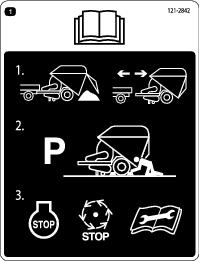







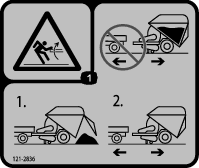
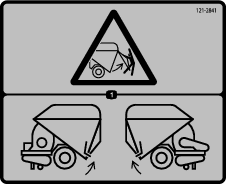

Setup
Note: Determine the left and right sides of the machine from the normal operating position.
Charging the Battery
Charge the battery before first use; refer to Charging the Battery.
Mounting the Machine to the Traction Unit
Parts needed for this procedure:
| Hitch pin | 1 |
| Lynch pin | 1 |
To ensure proper debris pickup, ensure that the machine frame is parallel with the ground.
-
Position the machine on a flat, level surface.
-
Remove the pin and rotate the jack to the ground. Align the holes and install the pin.
-
Adjust the jack so that the distance from the top of the frame to the ground is 59.7 cm (23-1/2 inches) (Figure 3).
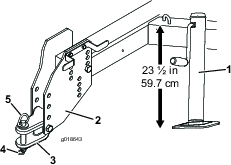
-
Back the traction unit up to the machine.
-
Adjust the hitch tongue to the same level as the hitch of the traction unit as follows:
-
Remove the bolts and locknuts securing the hitch tongue to the hitch plates (Figure 3).
-
Raise or lower the hitch tongue to the position approximately level with the prime move hitch and secure it with the bolts and locknuts.
Note: If you require additional height, you may remove, raise, lower or reverse the hitch plates.
-
-
Secure the hitch tongue to the traction unit hitch with the hitch pin and lynch pin (Figure 3).
-
Raise the jack, remove the pin, rotate the jack to the storage position and secure with the pin.
Removing the Machine from the Traction Unit
Warning
Disconnecting the machine from the traction unit may allow the machine to tip backward, causing injury.
Always empty the hopper before disconnecting the machine from the traction unit.
-
Park the machine on a level surface and chock the wheels.
-
Remove the pin and rotate the jack down. Align the holes and install the pin.
-
Lower the jack to the ground to stabilize the machine.
-
Continue to raise the machine with the jack until the lynch pin and hitch pin can be removed from the hitch.
-
Move the traction unit away from the machine.
-
Store the lynch pin and hitch pin in the hitch tongue.
Installing the CE Kit
Parts needed for this procedure:
| CE Kit (ordered separately; refer to your authorized Toro distributor) | 1 |
If you operate the machine in a country that complies to CE standards, install the CE Kit; refer to the kit Installation Instructions.
Product Overview
Flap Lever
Move the flap lever downward to the engaged position and upward for the disengaged position. Move the lever to the upward position when transporting the machine.
Note: You may position the flap in the raised position when picking up large amounts of leaves.
Reel Lever
Move the reel lever forward to raise the flex tip reel. To lower the flex reel, move the lever forward, release the catch, then move the lever to the rear until it hits the stop. Move the lever to the raised position when the machine is not in operation, when storing the machine, or when transporting the machine (Figure 4).
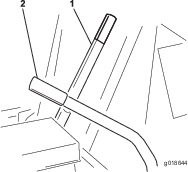
Choke Control
To start a cold engine, close the carburetor choke by moving the choke control lever to the ON position. After the engine starts, regulate the choke to keep the engine running smoothly. Open the choke by moving the lever to the OFF position. Starting a warm engine requires little or no choking (Figure 5).
Ignition Switch
The ignition switch, which is used to start and shut off the engine, has three positions: OFF, RUN, and START. Rotate the key clockwise to the START position to engage the starter motor. Release the key when the engine starts (Figure 5). The key will move automatically to the RUN position. To shut off the engine, rotate the key counterclockwise to the OFF position.
Throttle Control
The throttle (Figure 5) is used to operate the engine at various speeds. Moving the throttle lever to the FAST position increases the engine speed. To decrease the engine speed, move the lever to the SLOW position.
Note: When operating the machine, run the engine at full throttle. Operating the machine at a slow speed may damage the clutch.
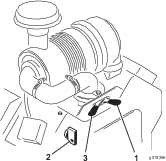
Tailgate Latch Rope
Pull the tailgate latch rope to unlatch the tailgate when emptying the hopper (Figure 6). When the rope is not in use, wind it around the harness mount.

Tailgate Latch
The tailgate latch is used to assist in the unlatching of the tailgate when emptying the hopper (Figure 7).
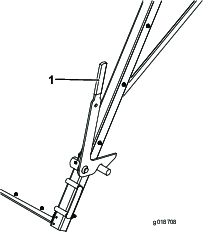
Note: Specifications and design are subject to change without notice.
| Width | 226 cm (89 inches) |
| Length | 419 cm (165 inches) |
| Height | 234 cm (92 inches) |
| Empty Weight | 1322 kg (2,914 lb) |
Operation
Before Operation Safety
General Safety
-
Never allow children or untrained people to operate or service the machine. Local regulations may restrict the age of the operator. The owner is responsible for training all operators and mechanics.
-
Become familiar with the safe operation of the equipment, operator controls, and safety signs.
-
Know how to stop the machine and shut off the engine quickly.
-
Keep all shields, safety devices, and decals in place. Repair or replace all safety devices and replace all illegible or missing decals. Do not operate the machine unless they are present and functioning properly.
-
The machine has different balance, weight, and handling characteristics compared to some other types of towed equipment.
-
Ensure that the traction unit is suitable for use with an implement of this weight by checking with the traction unit supplier or manufacturer.
-
Do not modify this equipment in any manner.
Fuel Safety
-
Use extreme care in handling fuel. It is flammable and its vapors are explosive.
-
Extinguish all cigarettes, cigars, pipes, and other sources of ignition.
-
Use only an approved fuel container.
-
Do not remove the fuel cap or fill the fuel tank while the engine is running or hot.
-
Do not add or drain fuel in an enclosed space.
-
Do not store the machine or fuel container where there is an open flame, spark, or pilot light, such as on a water heater or other appliance.
-
If you spill fuel, do not attempt to start the engine; avoid creating any source of ignition until the fuel vapors have dissipated.
Adding Fuel
Fuel Recommendations
-
For best results, use only clean, fresh (less than 30 days old), unleaded gasoline with an octane rating of 87 or higher ((R+M)/2 rating method).
-
Ethanol: Gasoline with up to 10% ethanol (gasohol) or 15% MTBE (methyl tertiary butyl ether) by volume is acceptable. Ethanol and MTBE are not the same. Gasoline with 15% ethanol (E15) by volume is not approved for use. Never use gasoline that contains more than 10% ethanol by volume, such as E15 (contains 15% ethanol), E20 (contains 20% ethanol), or E85 (contains up to 85% ethanol). Using unapproved gasoline may cause performance problems and/or engine damage which may not be covered under warranty.
-
Do not use gasoline containing methanol.
-
Do not store fuel either in the fuel tank or in fuel containers over the winter unless you use a fuel stabilizer.
-
Do not add oil to gasoline.
Important: To reduce starting problems, add fuel stabilizer to the fuel all season, mixing it with fuel less than 30 days old; run the machine dry before storing it for more than 30 days.Do not use fuel additives other than a fuel stabilizer/conditioner. Do not use fuel stabilizers with an alcohol base such as ethanol, methanol, or isopropanol.
Filling the Fuel Tank
Fuel tank capacity: 37.8 L (10 US gallons)
-
Park the machine on a level surface, shut off the engine, and allow the engine to cool.
-
Clean around the fuel-tank cap and remove it.
-
Fill the tank to approximately 25 mm (1 inch) below the top of the tank (the bottom of the filler neck).
Important: This space in the tank allows the fuel to expand. Do not fill the fuel tank completely full.
-
Install the fuel-tank cap securely.
-
Wipe up any spilled fuel.
Checking the Engine-Oil Level
The engine is shipped with high-quality oil in the crankcase; however, the oil level must be checked before and after the engine is first started.
Crankcase capacity is approximately 1.9 L (2 US qt) with the filter.
Note: The best time to check the engine oil is when the engine is cool before it has been started for the day. If it has already been run, allow the oil to drain back down to the sump for at least 10 minutes before checking. If the oil level is at or below the Add mark on the dipstick, add oil to bring the oil level to the Full mark. Do not overfill. If the oil level is between the Full and Add marks, you do not need to add oil.
-
Park the machine on a level surface, shut off the engine, remove the key, and wait for all moving parts to stop before leaving the operating position.
-
Clean around the oil dipstick so that dirt cannot fall into the filler hole and damage the engine (Figure 8).
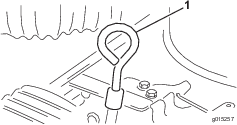
-
Remove the dipstick, wipe it clean, and install it until it is fully seated.
-
Remove the dipstick and check the oil level on the dipstick.
The oil level should be up to the Full mark on the metal end of the dipstick.
-
If the oil level is below the Full mark, remove the filler tube cap and add oil until the level reaches the Full mark on the dipstick (Figure 9).
Important: Do not overfill the crankcase with oil because this may cause engine damage. Do not run the engine with oil below the low mark because the engine may be damaged as a result.

-
Install the filler tube cap and dipstick.
During Operation Safety
-
The owner/operator can prevent and is responsible for accidents that may cause personal injury or property damage.
-
Wear appropriate clothing, including eye protection; long pants; substantial, slip-resistant footwear; and hearing protection. Tie back long hair and do not wear loose clothing or loose jewelry.
-
Do not operate the machine while ill, tired, or under the influence of alcohol or drugs.
-
Do not allow passengers to ride on the machine.
-
Operate the machine outdoors or in a well-ventilated area only.
-
Operate the machine only in good visibility. Watch for holes, ruts, bumps, rocks, or other hidden objects. Uneven terrain could overturn the machine. Tall grass can hide obstacles. Use care when approaching blind corners, shrubs, trees, or other objects that may obscure your vision.
-
Always watch out for and avoid low overhangs such as tree limbs, door jambs, overhead walkways, etc.
-
Look behind and down before reversing the machine to be sure of a clear path.
-
Do not drive the machine near drop-offs, ditches, or embankments. The machine could suddenly roll over if a wheel goes over the edge or if the edge gives way.
-
If the machine ever vibrates abnormally, stop the machine immediately, shut off the engine, remove the key, wait for all moving parts to stop, and inspect for damage. Repair all damage to the machine before resuming operation.
-
Reduce the ground speed of the machine when operating on rough, uneven terrain, and near curbs, holes, and other sudden changes in terrain. Loads may shift, causing the machine to become unstable.
-
Do not touch the engine or the exhaust while the engine is running, or soon after you shut off the engine, because these areas may be hot enough to cause burns.
-
Do not leave a running machine unattended.
-
Do not operate the machine when there is the risk of lightning.
-
Always maintain proper traction unit tire pressure.
-
The maximum transport speed is 32 km/h (20 mph) with slower speeds required on hilly terrain.
-
Shut off the engine when dumping the contents of the hopper. Do not stand directly behind the hopper.
-
Ensure that the machine is connected to the traction unit before dumping the hopper.
-
Do not carry loads that exceed the load limits of the machine or the traction unit.
-
The stability of load changes as the hopper fills.
-
To avoid causing the machine to tip over, be careful when turning and avoid unsafe maneuvers.
-
Unload the machine or disconnect it from the traction unit while on a level surface.
Slope Safety
Slopes are a major factor related to loss-of-control and tip-over accidents, which can result in severe injury or death.
-
Review the traction unit specifications to ensure that you do not exceed its slope capabilities.
-
Survey the site to determine which slopes are safe for operating the machine and establish your own procedures and rules for operating on those slopes. Always use common sense and good judgment when performing this survey.
-
If you feel uneasy operating the machine on a slope, do not do it.
-
Keep all movement on slopes slow and gradual. Do not suddenly change the speed or direction of the machine.
-
Avoid operating the machine on wet terrain. Tires may lose traction. A rollover can occur before the tires lose traction.
-
Travel straight up and down a slope.
-
Turning while going up or down a slope can be dangerous. If you must turn on a slope, do it slowly and cautiously.
-
Heavy loads affect stability on a slope. Carry a reduced load and reduce your ground speed when operating on a slope or if the machine has a full hopper.
-
Avoid starting, stopping, or turning the machine on a slope, especially with a full hopper. Stopping while going down a slope takes longer than stopping on level ground. If you must stop the machine, avoid sudden speed changes, which can cause the machine to tip or roll over.
Starting the Engine
-
Place all the controls in the OFF or DISENGAGED position.
-
Move the throttle lever midway between the SLOW and FAST position.
-
Move the choke lever to the ON position.
Note: Choke is not required when starting a warm engine.
-
Insert the key into the ignition switch and rotate it clockwise to start the engine. Release the key when the engine starts. Regulate the choke to keep the engine running smoothly.
Important: To prevent overheating of the starter motor, do not engage the starter longer than 10 seconds. After 10 seconds of continuous cranking, wait 60 seconds before engaging the starter motor again.
-
Move the throttle lever to the desired engine speed.
-
Pull the flap lever as far forward as possible.
-
Push the reel lever forward until the catch releases, then push it to the rear until the lever hits STOP.
Note: Do not allow the machine to stand still with the rake engaged as turf damage may occur.
Shutting Off the Engine
-
Move the throttle lever to the SLOW position.
-
Let the engine idle for 60 seconds.
-
Turn the ignition key to the OFF position and remove the key.
Note: To stop the machine in an emergency, move the ignition switch to the OFF position.
Adjusting the Rake Depth
The flex tip reel should be adjusted to ensure that the rake tips slightly touch surface but do not penetrate the turf.
-
Position the machine on a level surface.
-
Turn the depth-adjustment bolt until the rake slightly contacts the top of the turf grass. If a broom is installed, slight contact should be made with the surface. When the broom is operating, the contact width surface should be about 25 mm (1 inch) wide across the entire length of the broom (Figure 10).
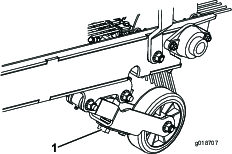
-
Repeat the procedure on the opposite side of the machine.
After Operation Safety
-
Park the machine on a firm, level surface. Avoid soft ground because the jack stand could sink and cause the machine to tip over.
-
Shut off the engine and remove the key. Wait for all movement to stop and allow the machine to cool before adjusting or cleaning it.
-
Do not disconnect the machine from the traction unit on hills or without engaging the front jack.
-
Ensure that the jack stand and the hopper are in the down position before disconnecting the machine.
-
When disconnecting the machine, always chock the wheels to prevent movement.
-
Allow the engine to cool before storing the machine in any enclosure.
-
Do not store the machine or fuel container where there is an open flame, spark, or pilot light, such as on a water heater or other appliance.
-
Keep all parts of the machine in good working condition and all hardware tightened.
-
Replace all worn, damaged, or missing decals.
Inspecting and Cleaning Up after Operation
After sweeping, thoroughly clean and wash the machine. Air out the dry hopper. After cleaning, inspect the machine for possible damage to the mechanical components and blower.
Important: When towing the machine for long distances, fasten the gauge wheel arm securely to the machine frame with the transport hooks. Allowing the gauge wheel arm to fall to the ground may damage the machine.
Operating Tips
General
-
Before starting to sweep, survey area to determine the best direction to sweep.
Note: To maintain a straight line when sweeping, sight of an object in the foreground.
-
Always try to make a long, continuous run with a slight overlap on the return run.
-
On turf areas, the flex tip reel picks up twigs, clippings, leaves, pine needles and cones, small debris (beverage cans, small bottles, paper plates, etc.).
-
The rake teeth are made of flexible nylon and easily changed. To prevent damage, the rake is protected from solid obstructions by spring action. The nylon teeth do not mar bronze, stone markers, sidewalks or pavement.
-
Because of its unique design, the machine also grooms the turf. The flex tip reel combs through and lifts grass for a uniform cut when mowed. As it cleans, the light scarifying action increases water and pesticide penetration, thus reducing the need for renovation.
Important: Do not make sharp turns when using the thatching reel to prevent damaging the turf.
Important: Do not operate the machine while the reel is turning and in the raised position. Damage to the rake and tires may result if teeth come in contact with tires.
-
To empty the hopper, pull the tailgate latch rope.
Maintenance
Important: Refer to your engine owner’s manual for additional maintenance procedures.
Recommended Maintenance Schedule(s)
| Maintenance Service Interval | Maintenance Procedure |
|---|---|
| After the first 50 hours |
|
| Before each use or daily |
|
| Every 25 hours |
|
| Every 100 hours |
|
| Every 200 hours |
|
| Every 600 hours |
|
| Before storage |
|
Maintenance Safety
-
Before servicing or adjusting the machine, remove it from the traction unit, shut off the engine, remove the key, and wait for all moving parts to stop.
-
Stop the machine on level ground, empty the hopper, and chock the wheels before removing the machine from the traction unit.
-
Perform only those maintenance instructions described in this manual. If major repairs are ever needed or you need assistance, contact an authorized Toro distributor.
-
Support the machine with blocks or jack stands when working beneath it.
-
Do not rely on the hydraulic system of the traction unit to support the machine when working beneath it.
-
Ensure that all guards are installed and the hood is shut securely after maintaining or adjusting the machine.
-
Do not allow untrained personnel to service the machine.
-
Use jack stands to support the machine or components when required.
-
Carefully release pressure from components with stored energy.
-
Do not charge the batteries while servicing the machine.
-
To reduce the potential fire hazard, keep the engine area free of excessive grease, grass, leaves, and accumulation of dirt.
-
If possible, do not perform maintenance while the engine is running. Keep away from moving parts.
-
If you must run the engine to perform a maintenance adjustment, keep your hands, feet, clothing, and all other parts of your body away from the engine and any moving parts. Keep bystanders away from the machine.
-
Clean up oil and fuel spills.
-
Keep all parts in good working condition and all hardware tightened. Replace all worn or damaged decals.
-
Do not interfere with the intended function of a safety device. or reduce the protection provided by a safety device. Check their proper operation regularly.
-
Do not overspeed the engine by changing the governor settings. To ensure safety and accuracy, have an authorized Toro distributor to check the maximum engine speed with a tachometer.
-
If major repairs are ever necessary or assistance is required, contact an authorized Toro distributor.
-
Altering this machine in any manner may affect the operation of the machine, performance, durability, or its use may result in injury or death. Such use could void the product warranty of The Toro® Company.
Pre-Maintenance Procedures
Preparing the Machine for Maintenance
Warning
Disconnecting the machine from the traction unit may allow the machine to tip backward, causing injury.
Always empty the hopper before disconnecting the machine from the traction unit.
-
Park the traction unit and machine on a level surface and engage the parking brake.
-
Shut off the traction unit engine and remove the key.
-
Shut off the machine engine, wait for all moving parts to stop, and remove the key.
-
Chock the wheels of the machine.
-
Remove the pin and rotate the jack down. Align the holes and install the pin.
-
Lower the jack to the ground to stabilize the machine.
Important: Store the machine on the jack stand on a firm, level surface so that it does not sink or tip over.
-
Raise the machine with the jack and remove the pin from the hitch.
-
Move the traction unit away from the machine.
-
Store the lynch pin and the hitch pin in the machine hitch tongue.
Lubrication
Lubricating the Machine
| Maintenance Service Interval | Maintenance Procedure |
|---|---|
| Before each use or daily |
|
| Every 25 hours |
|
This machine has grease fittings that you must lubricate regularly with No. 2 lithium grease. Lubricate the bearings whenever machine is washed with water. Dusty and dirty operating conditions could cause dirt to get into the bearings and bushings, resulting in accelerated wear. The grease fittings that you must lubricate include: the gauge wheel bearings, the reel shaft bearings, the impeller shaft bearings, the jackshaft bearings, and the left and right trailing arms.
Engine Maintenance
Servicing the Air Cleaner
| Maintenance Service Interval | Maintenance Procedure |
|---|---|
| Every 25 hours |
|
Check the air-cleaner housing for damage, which could cause an air leak. Replace the air cleaner housing if it is damaged. Check the whole intake system for leaks, damage, or loose hose clamps.
Removing the Air Filters
-
Refer to Preparing the Machine for Maintenance.
-
Release latches securing air-cleaner cover to air-cleaner body. Separate the cover from the body (Figure 14).
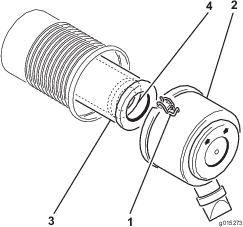
-
Clean the inside of the air-cleaner cover with compressed air.
-
Gently slide the primary filter out of the air-cleaner housing (Figure 14).
Note: Avoid knocking the filter into the side of the housing.
-
Remove the safety filter only if you intend to replace it.
Important: Do not attempt to clean the safety filter. If the safety filter is dirty, the primary filter is damaged. Replace both filters.
-
Inspect the primary filter for damage by looking into the filter while shining a bright light on the outside of the filter. Holes in the filter appear as bright spots. If the filter is damaged, discard it.
Servicing the Primary Air Filter
| Maintenance Service Interval | Maintenance Procedure |
|---|---|
| Every 200 hours |
|
-
If the primary air filter is dirty, bent, or damaged, replace it.
-
Do not clean the primary air filter.
Servicing the Safety Air Filter
| Maintenance Service Interval | Maintenance Procedure |
|---|---|
| Every 600 hours |
|
Important: Do not attempt to clean the safety air filter. If the safety air filter is dirty, then the primary air filter is damaged. Replace both filters.
Installing the Filters
Important: To prevent engine damage, always operate the engine with both air filters and cover installed.
-
If installing new filters, check each filter for shipping damage. Do not use a damaged filter.
-
If the safety filter is being replaced, carefully slide it into the filter body (Figure 14).
-
Carefully slide the primary filter over the safety filter (Figure 14).
Note: Ensure that the primary filter is fully seated by pushing on its outer rim while installing it.
Important: Do not press on the soft inside area of the filter.
-
Clean the dirt ejection port located in the removable cover. Remove the rubber outlet valve from the cover, clean the cavity and replace the outlet valve.
-
Install the air-cleaner cover with the side indicated as up facing upward and secure the latches (Figure 14).
Changing the Engine Oil and Filter
| Maintenance Service Interval | Maintenance Procedure |
|---|---|
| After the first 50 hours |
|
| Every 100 hours |
|
Note: Change the oil and filter more frequently when operating conditions are extremely dusty or sandy.
Oil Type: Detergent oil (API service SJ, SK, SL, or higher)
Crankcase Capacity: w/filter, 1.9 L (2 US qt)
-
Start the engine and let it run for 5 minutes. This warms the oil so it drains better.
-
Park the machine so that the drain side is slightly lower than the opposite side to ensure that the oil drains completely.
-
Set the traction unit parking brake, shut off the machine engine, and remove the key.
-
Place a pan below the oil drain. Remove the oil drain plug to allow the oil to drain (Figure 15).
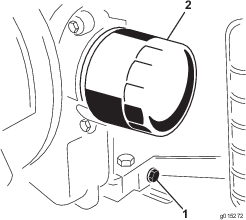
-
When the oil has drained completely, replace the plug.
Note: Dispose of the used oil at a certified recycling center.
-
Place a shallow pan or rag under the filter to catch oil.
-
Remove the old filter and wipe the surface of the filter adapter gasket.
-
Pour the new oil through the center hole of the filter. Stop pouring when the oil reaches the bottom of the threads.
-
Allow a minute or 2 for the oil to be absorbed by filter material, then pour off the excess oil.
-
Apply a thin coat of new oil to the rubber gasket on the replacement filter.
-
Install the replacement filter to the filter adapter. Turn the oil filter clockwise until the rubber gasket contacts the filter adapter, then tighten the filter an additional 1/2 turn. Do not overtighten.
-
Check the oil level.
-
Slowly add additional oil to bring the level to the full mark on the dipstick.
-
Replace the fill cap.
Servicing the Spark Plugs
| Maintenance Service Interval | Maintenance Procedure |
|---|---|
| Every 200 hours |
|
Ensure that the air gap between the center and side electrodes is correct before installing each spark plug. Use a spark plug wrench for removing and installing the spark plugs and a gapping tool/feeler gauge to check and adjust the air gap. Install new spark plugs if necessary.
Type: Champion RC12YC or equivalent. Air Gap: 0.75 mm (0.03 inch)
Removing the Spark Plugs
-
Refer to Preparing the Machine for Maintenance.
-
Pull the wires off the spark plugs.
-
Clean around the spark plugs.
-
Remove both spark plugs and metal washers.
Checking the Spark Plugs
-
Look at the center of both spark plugs (Figure 16). If you see light brown or gray on the insulator, the engine is operating properly. A black coating on the insulator usually means the air cleaner is dirty.
Important: Do not clean the spark plugs. Always replace the spark plugs when they have a black coating, worn electrodes, an oily film, or cracks.

-
Check the gap between the center and side electrodes (Figure 16).
-
Bend the side electrode (Figure 16) if the gap is not correct.
Installing the Spark Plugs
-
Thread the spark plugs into the spark-plug holes.
-
Tighten the spark plugs to 27 N·m (20 ft-lb).
-
Push the wires onto the spark plugs.
Remove Debris from the Engine
| Maintenance Service Interval | Maintenance Procedure |
|---|---|
| Every 100 hours |
|
To ensure proper cooling, keep the grass screen, cooling fins, and other external surfaces of the engine clean at all times.
Remove the blower housing and other cooling shrouds. Clean the cooling fins and external surfaces as necessary. Ensure that the cooling shrouds are installed before operation.
Note: Operating the engine with a blocked grass screen, dirty or plugged cooling fins, or cooling shrouds removed, will damage the engine due to overheating.
Fuel System Maintenance
Replacing the Fuel Filter
| Maintenance Service Interval | Maintenance Procedure |
|---|---|
| Every 600 hours |
|
Important: Do not install a dirty filter after it has been removed from the fuel line.
-
Refer to Preparing the Machine for Maintenance.
-
Allow the machine to cool down.
-
Place a clean container under the fuel filter (Figure 17).
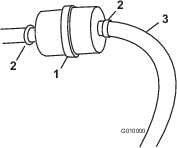
-
Loosen the clamps securing the fuel filter to the fuel lines.
-
Remove the filter from the fuel lines.
-
Install a new filter to the fuel lines with the clamps previously removed. Filter is to be mounted so that the arrow points toward the carburetor.
-
Wipe up any spilled fuel.
Electrical System Maintenance
Charging the Battery
Warning
Charging the battery produces gasses that can explode.
Never smoke near the battery and keep sparks and flames away from the battery.
Warning
Battery terminals or metal tools could short against metal components of the traction unit or machine, causing sparks. Sparks can cause the battery gasses to explode, resulting in personal injury.
-
When removing or installing the battery, do not allow the battery terminals to touch any metal parts of the machine.
-
Do not allow metal tools to short between the battery terminals and any metal parts.
Warning
Incorrect battery cable routing could damage the machine and cables, causing sparks. Sparks can cause the battery gasses to explode, resulting in personal injury.
-
Always disconnect the negative (black) battery cable before disconnecting the positive (red) cable.
-
Always connect the positive (red) battery cable before connecting the negative (black) cable.
-
Unlatch and open the battery compartment cover.
-
Remove the battery from the battery compartment.
-
Clean the top of the battery.
-
Connect a 3 to 4 A battery charger to the battery posts. Charge the battery at a rate of 3 to 4 A for 4 to 8 hours.
-
When the battery is charged, disconnect the charger from the electrical outlet and battery posts.
-
Insert the battery into the tray in the battery compartment. Position the battery so that the terminals are to the inside.
-
Attach the positive cable (red cable from the ignition switch) to the positive (+) terminal.
-
Attach the negative cable (black cable from the engine block) to the negative (–) terminal of the battery.
Important: Ensure that there is clearance between the battery cables and the speed selector lever. Verify that the speed selector lever does not come within 1 inch (2.5 cm) of either battery cable when it is moved through its entire range of motion. Do not wire or tape the negative and positive battery cables together.
-
Coat the terminals and mounting fasteners with petroleum jelly to prevent corrosion.
-
Install the battery cover and secure it with the springs.
Servicing the Battery
| Maintenance Service Interval | Maintenance Procedure |
|---|---|
| Every 25 hours |
|
The battery cables must be tight on the terminals to provide good electrical contact.
Warning
Incorrect battery cable routing could damage the machine and cables, causing sparks. Sparks can cause the battery gasses to explode, resulting in personal injury.
-
Always disconnect the negative (black) battery cable before disconnecting the positive (red) cable.
-
Always connect the positive (red) battery cable before connecting the negative (black) cable.
If corrosion occurs at the terminals, disconnect the cables (negative (–) cable first) and scrape clamps and terminals separately. Connect the cables (positive (+) cable first) and coat the terminals with petroleum jelly.
Warning
Battery terminals or metal tools could short against metal traction unit components, causing sparks. Sparks can cause the battery gasses to explode, resulting in personal injury.
-
When removing or installing the battery, do not allow the battery terminals to touch any metal parts of the machine.
-
Do not allow metal tools to short between the battery terminals and metal parts of the machine.
Drive System Maintenance
Tire Maintenance
Checking the Tire Pressure
| Maintenance Service Interval | Maintenance Procedure |
|---|---|
| Before each use or daily |
|
Maintain the air pressure in the front and rear tires at 193 kPa (28 psi). Check the pressure at the valve stem (Figure 18) before each use.

Changing the Tires
Warning
A vehicle on a jack may be unstable and slip off of the jack, injuring anyone beneath it.
-
Do not start the vehicle while the vehicle is on a jack.
-
Always remove the key from the switch before getting off of the vehicle.
-
Chock the tires when the vehicle is on a jack.
Important: Use a 900 kg (2,000 lb) capacity hydraulic jack when changing a tire.
-
Refer to Preparing the Machine for Maintenance.
-
Place the jack under the frame or axle shaft behind the wheel and jack up the wheel until it just contacts the floor.
-
Loosen all lug bolts and continue to jack up the machine until you can remove the tire.
-
Reverse the steps above to install a tire.
-
Torque the lug bolts to 95 to 122 N·m (70 to 90 ft-lb).
Belt Maintenance
Inspecting the Belts
Refer to Preparing the Machine for Maintenance.
Note: It is not necessary to remove the upper belt guard (Figure 19) to check the belt tension. If you remove the belt guard, remove the 4 bolts, washers, and nuts securing the guard to the frame. Do not operate the machine without the guards in place.

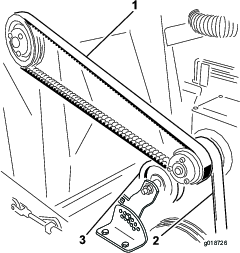
Inspecting the Impeller Drive Belt
Check the tension by pressing the belt at the midspan of the impeller and clutch pulleys with 18 to 22 N (4 to 5 lb) of force. The belt should deflect 1.3 cm (1/2 inch). If the deflection is incorrect, refer to Adjusting the Impeller Drive Belt. If the deflection is correct, continue normal operation (Figure 19).
Inspecting the Jackshaft Belt
Check the tension by pressing the belt at midspan of the jackshaft and clutch pulleys with 18 to 22 N (4 to 5 lb) of force. The belt should deflect 6 mm (1/4 inch). If the deflection is incorrect, refer to Adjusting the Jackshaft Belt. If the deflection is correct, continue normal operation (Figure 19).
Inspecting the Reel Drive Belt
Check the tension by pressing the belt at midspan of the idler pulley and the reel driver pulley with 111 to 129 N (25 to 29 lb) of force. The belt should deflect 6 mm (1/4 inch). If the deflection is incorrect, refer to Adjusting the Reel Drive Belt. If the deflection is correct, continue normal operation.
Adjusting the Belts
Adjusting the Impeller Drive Belt
-
Refer to Preparing the Machine for Maintenance.
-
Loosen the engine mounting bolts (Figure 21).
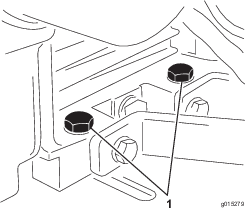
-
Loosen the jam nut and turn the belt adjusting bolt until you obtain the desired belt tension (Figure 22).
-
Slightly tighten the engine mounting bolts.
-
Adjust the engine so that it is parallel with frame. Continue tightening the engine mounting bolts (Figure 22).

-
Whenever you adjust the impeller belt, also adjust the jackshaft belt; refer to Inspecting the Jackshaft Belt.
Adjusting the Jackshaft Belt
-
Remove the 4 bolts, washers and nuts securing the upper shroud to the frame (Figure 19).
-
Remove the nut and bolt securing the idler pulley bracket to the tension adjusting bracket (Figure 23).
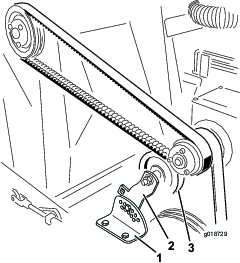
-
Press down the idler pulley until you obtain the desired tension and the holes in the idler pulley bracket and the tension adjusting bracket are aligned.
-
Install the bolt and nut to secure the adjustment.
-
Install the upper shroud.
Adjusting the Reel Drive Belt
-
Remove the nut and bolt securing the idler pulley bracket (bolt in slotted hole in bracket) to the tension-adjusting bracket (Figure 24).
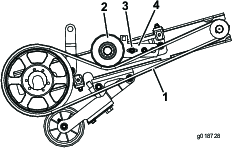
-
Press down on the idler pulley until you obtain the desired tension and the holes in the idler pulley bracket and the tension-adjusting bracket are aligned.
-
Install the bolt and nut to secure the adjustment.
Miscellaneous Maintenance
Changing the Rubber Flap
Replace the rubber flap when it becomes worn or damaged.
Caution
Failing to chock the wheels may allow the machine to roll, which may cause personal injury.
Change the rubber flap only on a flat, level surface and chock the wheels to prevent the machine from rolling.
-
Refer to Preparing the Machine for Maintenance.
-
Remove the 10 bolts, washers, and nuts on the mounting flap and flap retainer (Figure 25).
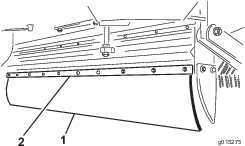
-
Replace with the new rubber flap and fasten it securely.
Removing the Pulley
-
Remove the bolts and lockwashers 1 at a time and screw them into the adjoining holes (Figure 26).
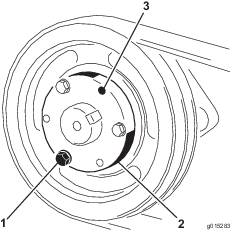
-
Turn each bolt the same number of times until the lock separates. The pulley should now slide off of the shaft.
Removing the Flex Tip Reel
-
Refer to Preparing the Machine for Maintenance.
-
Raise the front of the machine as high as possible by lowering the jack.
-
Raise the reel to the highest position.
-
Remove the lower belt guard and reel drive belt (Figure 24).
-
Remove the 2 bolts, lockwashers, and nuts securing the reel shaft bearings to the reel support arms on each side of the machine. Lower the flex tip reel to the ground.
-
Lift the reel support arms to the highest position.
-
Slide the end of the rake rearward and pull it out from under the machine.
Replacing the Rake Rod or Finger Plate
-
Refer to Preparing the Machine for Maintenance.
-
Remove the bolt and locknut from 1 end of the rake rod (Figure 27).
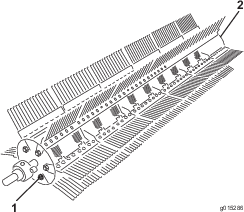
-
Remove the locknut only from the opposite end of the rake rod.
-
Drive the rake rod from the end plate. Drive the rod from the end without the tab welded to it.
-
Remove the finger plates or rods as required and replace.
-
Line up the finger plate with the rod and drive the rod back through the end plate.
-
Attach the bolt, locknuts, and hook up the springs.
Replacing the Flex Tip Rake Tine
-
Refer to Preparing the Machine for Maintenance.
-
Remove the tine retainer and slide the damaged tine out (Figure 28).

-
Bend the new tine in half and slide it into position.
-
Place the tine bracket over the curved end of the tine and fasten it securely with the bolt and lockwasher.
Replacing the Brush Half
-
Refer to Preparing the Machine for Maintenance.
-
Remove the brush from the machine.
-
Loosen the clamps with an Allen wrench and remove it from the brush halves (Figure 29).
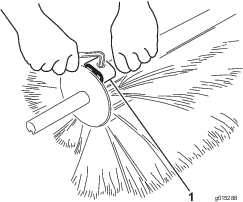
-
Separate the brush halves and discard the damaged section(s) (Figure 30).
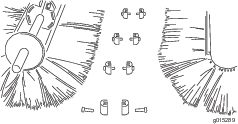
-
Install the new brush section by pushing them together and securing both ends with the brush clamps. When the ends have been secured, fasten the brush with the remaining clamps.
Cleaning
Cleaning the Blower Housing
Warning
Cleaning a blower housing while the impellers are moving may result in your hands coming into contact with a moving impeller, causing personal injury.
Shut off the engine, remove the key, and wait for all moving parts to stop before removing debris from the blower housing.
-
Refer to Preparing the Machine for Maintenance.
-
Ensure that the impeller has stopped rotating before removing the access plates.
-
Loosen the 2 wing nuts securing the access plate (Figure 31).
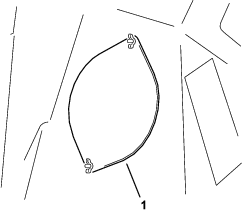
-
Swing the access plate to 1 side allowing the removal of debris.
-
After removing the debris, lower the access plate and secure it with the wing nuts. Repeat this procedure on the other access plate.
Storage
Preparing the Machine for Storage
-
Refer to Preparing the Machine for Maintenance.
-
Store the machine in a clean, dry garage or storage area.
-
Wash grass, dirt, and grime from the external parts of the entire machine, especially cylinder-head fins of the engine and blower housing.
Important: You can wash the machine with mild detergent and water. Do not pressure wash the machine. Avoid excessive use of water, especially near the engine.
Note: Run the machine with the engine at high idle for 2 to 5 minutes after washing.
-
Service the air cleaner; refer to Servicing the Air Cleaner.
-
Change the engine oil; refer to Changing the Engine Oil and Filter.
-
Check the tire pressure; refer to Checking the Tire Pressure.
-
Replace any damaged tines or brush halves; refer to Replacing the Flex Tip Rake Tine or Replacing the Brush Half.
-
Remove the spark-plug wire; refer to Servicing the Spark Plugs.
-
Remove the spark plugs and check their condition.
-
With the spark plugs removed from the engine, pour 2 tablespoons of engine oil into each spark-plug hole and use the starter to crank the engine to distribute the oil inside the cylinder.
-
Install the spark plugs, but do not install the wires on the spark plugs.
-
Tighten all fasteners. Repair or replace any part that is damaged or missing.
-
Spray light oil mist on the coring head bearings (crank and damper links).
-
Paint all scratched or bare metal surfaces. Paint is available from your authorized Toro distributor.
-
Cover the machine to protect it and keep it clean.
Storing the Machine Long-Term
If you are storing the machine for more than 30 days, prepare it as follows:
-
Refer to Preparing the Machine for Maintenance.
-
Add a petroleum-based stabilizer/conditioner to fuel in the tank. Follow mixing instructions from stabilizer manufacture.
Important: Do not use an alcohol-based stabilizer (ethanol or methanol).
Note: A fuel stabilizer/conditioner is most effective when mixed with fresh fuel and used at all times.
-
Run the engine to distribute conditioned fuel through the fuel system for 5 minutes.
-
Shut off the engine, allow it to cool and drain the fuel tank.
-
Start the engine and run it until it stops.
-
Choke the engine. Start and run the engine until it does not start.
-
Recycle any disposed fuel according to local codes.
Important: Do not store fuel containing stabilizer/conditioner longer than the duration recommended by the fuel-stabilizer manufacturer.
-
Remove the battery terminals from the battery posts and remove the battery from the machine.
-
Clean the battery, terminals, and posts with a wire brush and baking soda solution.
-
Coat the cable terminals and battery posts with grease or petroleum jelly to prevent corrosion.
-
Slowly charge the battery every 60 days for 24 hours to prevent lead sulfation of the battery.
Warning
Charging the battery produces gasses that can explode.
Do not smoke near the battery and keep sparks and flames away from it.
-
Ensure that the battery is fully charged to prevent freezing. The specific gravity of a fully charged battery is 1.26 to 1.30.
-
Store the battery either on the shelf or on the machine. Leave the cables disconnected if it is stored on the machine. Store the battery in a cool atmosphere to avoid rapid loss of charge from the battery.
